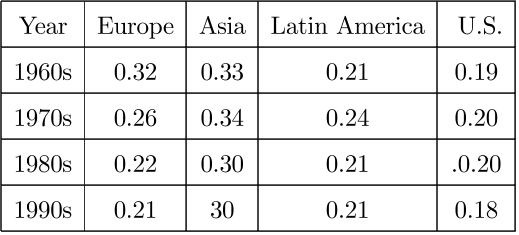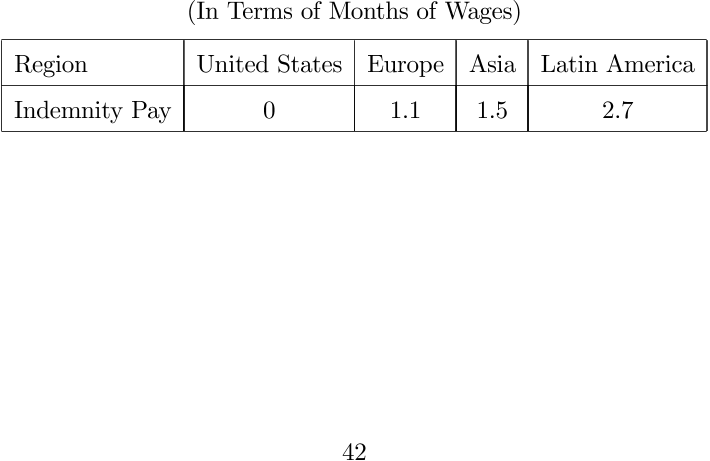Latin America in the rearview mirror
Harold L. Cole,Harold L. Cole,Lee E. Ohanian,Lee E. Ohanian,Lee E. Ohanian,Alvaro Riascos,James A. Schmitz +6 more
Reads0
Chats0
TLDR
This paper found that Latin American countries are the only Western countries that are poor and that are not gaining ground on the U.S. due to TFP differences, and that this failure is not plausibly accounted for by human capital differences, but rather reflects inefficient production.About:
This article is published in Journal of Monetary Economics.The article was published on 2005-01-01 and is currently open access. It has received 179 citations till now. The article focuses on the topics: Latin Americans & Total factor productivity.read more
Figures

Table 6. Investment-to-Output Ratios by Region (Regional Averages for Selected Countries) 
Table 4. Employment Rates by Region (Regional Averages for Selected Countries) 
Table 7. Bils-Klenow Relative Human Capital Levels (Regional Averages for Selected Countries, U.S. = 100) 
Table 5. Capital-to-Ouput Ratios by Decade Average Relative to the U.S.* 
Table 10. Government Ownership Share of the Top 10 Banks 
Table 11. Mandated Severance Pay
Citations
More filters
Posted Content
The Latin American Development Problem
TL;DR: The authors of as discussed by the authors found that the bulk of the difference in GDP per capita between Latin America and the United States is explained by low GDP per worker and, in particular, low total factor productivity in Latin America.
Journal ArticleDOI
Land Inequality and the Transition to Modern Growth
TL;DR: In this paper, the authors show that when land ownership is sufficiently concentrated, the landed elite will lobby the government to raise barriers to industrialization in order to protect its rents in the rural economy.
Posted Content
Import Substitution and Economic Growth
TL;DR: In this article, a dynamic Heckscher-Ohlin model with scale economies in the capital-intensive sector is used to model the trade regime in Latin America as a move to a closed economy.
Journal ArticleDOI
Threatening to Increase Productivity: Evidence from Brazil’s Oil Industry
TL;DR: In this paper, the authors studied the productivity at Brazil's state-owned oil company Petrobras and found that the threat of competition and privatization was sufficient to generate large productivity gains.
ReportDOI
Competitive Pressure and the Decline of the Rust Belt: A Macroeconomic Analysis
TL;DR: In this article, the authors formalize this thesis in a two-region dynamic general equilibrium model, in which productivity growth and regional employment shares are determined by the extent of competition.
References
More filters
ReportDOI
Economic Growth in a Cross Section of Countries
TL;DR: For 98 countries in the period 1960-1985, the growth rate of real per capita GDP is positively related to initial human capital (proxied by 1960 school-enrollment rates) and negatively related to the initial (1960) level as mentioned in this paper.
Journal ArticleDOI
Why Do Some Countries Produce so Much More Output Per Worker than Others
TL;DR: This paper showed that differences in physical capital and educational attainment can only partially explain the variation in output per worker, and that a large amount of variation in the level of the Solow residual across countries is driven by differences in institutions and government policies.
Journal ArticleDOI
Why do Some Countries Produce So Much More Output Per Worker than Others
Robert E. Hall,Charles I. Jones +1 more
TL;DR: This article showed that the differences in capital accumulation, productivity, and therefore output per worker are driven by differences in institutions and government policies, which are referred to as social infrastructure and called social infrastructure as endogenous, determined historically by location and other factors captured by language.
Journal ArticleDOI
Technology, Geography, and Trade
Jonathan Eaton,Samuel Kortum +1 more
TL;DR: This article developed a Ricardian trade model that incorporates realistic geographic features into general equilibrium and delivered simple structural equations for bilateral trade with parameters relating to absolute advantage, comparative advantage, and geographic barriers.
Journal ArticleDOI
The Regulation of Entry
TL;DR: In this article, the authors present new data on the regulation of entry of start-up firms in 85 countries, covering the number of procedures, official time, and official cost that a startup must bear before it can operate legally.
Related Papers (5)
Why do Some Countries Produce So Much More Output Per Worker than Others
Robert E. Hall,Charles I. Jones +1 more